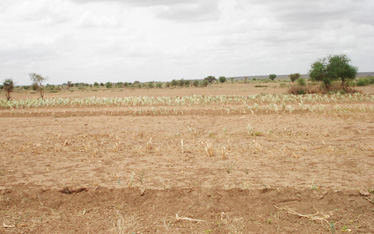Famine continues; observed improvements contingent on continued response
Issued: November 18, 2011
 NAIROBI/WASHINGTON NOVEMBER 18, 2011 – Recent analysis by FSNAU and FEWS NET confirms that Famine will persist through December 2011 in agropastoral areas of Middle Shabelle and among Afgoye and Mogadishu IDP populations. In areas of Bay, Bakool, and Lower Shabelle formerly classified as IPC Phase 5 – Famine, substantial humanitarian assistance has mitigated the most extreme food deficits and reduced mortality levels. Therefore, these areas have been downgraded to IPC Phase 4 – Emergency for the November/December 2011 period. However, nearly 250,000 people continue to face imminent starvation; Global Acute Malnutrition (GAM) remains near or above Famine levels (>30 percent) in many regions; and death rates, especially for young children, remain extremely high, in part due to continued outbreaks of measles, cholera, and malaria. Tens of thousands of people have died since April and deaths are likely to continue over the coming months. Overall, food security outcomes remain the worst in the world, and the worst in Somalia since the 1991/92 Famine. Continued multisectoral response, at scale, is required and any significant interruption to humanitarian assistance or trade would result in a return to Famine.
NAIROBI/WASHINGTON NOVEMBER 18, 2011 – Recent analysis by FSNAU and FEWS NET confirms that Famine will persist through December 2011 in agropastoral areas of Middle Shabelle and among Afgoye and Mogadishu IDP populations. In areas of Bay, Bakool, and Lower Shabelle formerly classified as IPC Phase 5 – Famine, substantial humanitarian assistance has mitigated the most extreme food deficits and reduced mortality levels. Therefore, these areas have been downgraded to IPC Phase 4 – Emergency for the November/December 2011 period. However, nearly 250,000 people continue to face imminent starvation; Global Acute Malnutrition (GAM) remains near or above Famine levels (>30 percent) in many regions; and death rates, especially for young children, remain extremely high, in part due to continued outbreaks of measles, cholera, and malaria. Tens of thousands of people have died since April and deaths are likely to continue over the coming months. Overall, food security outcomes remain the worst in the world, and the worst in Somalia since the 1991/92 Famine. Continued multisectoral response, at scale, is required and any significant interruption to humanitarian assistance or trade would result in a return to Famine.
The ongoing Famine in southern Somalia has two primary causes. First, the total failure of the October-December 2010 Deyr rains and the poor performance of the April-June 2011 Gu rains resulted in the worst annual crop production in 17 years, excess animal mortality, and very high food prices. Second, humanitarian assistance in the south was extremely limited until September/October due to a combination of inadequate response by the international community and severely restricted humanitarian access. Since September, substantial flows of food aid commodities onto local markets, in combination with Gu and off-season cereal harvests, have brought prices down from the record levels of June/July 2011, but they remain higher than both last year and the five-year average in almost all markets of the south. Aside from Lower Shabelle, where cereal price declines have been the largest and off-season harvests the most substantial, the cereal value of both daily wages and livestock remain low.
The massive scale-up of emergency response since September/October has also had a significant impact on both acute malnutrition and mortality. For example, in Middle/Lower Juba the average GAM prevalence across all livelihoods dropped from 35.1 percent in August to 29.3 percent in October. Significant declines were also observed in Bay Region and among Mogadishu IDPs. Crude death rates have also declined in many areas. However, even with these improvements, current levels of malnutrition and crude mortality remain two to four times higher than typical levels in Somalia for this time of year. Under-5 death rates remain up to six times the typical background level for Sub-Saharan Africa.
In the most-likely scenario, Famine is not expected in Somalia during 2012, with the potential exception of some IDP populations. However, given the significant impact of the 2011 Famine on livelihoods, health, and cereal availability, and current expectations of a late and possibly below-average 2012 Deyr harvest, large areas of southern Somalia are likely to remain in Phase 4 – Emergency until the August 2012 Gu-season harvests. Emergency-level food insecurity is characterized by substantial household food deficits, a GAM prevalence above 15 percent, and elevated mortality levels (CDR > 1/10,000/day). The size of the population in need of emergency assistance to save both lives and livelihoods will likely remain near current levels (4 million people) for the coming nine months. In addition, the risk of large-scale disease outbreaks remains and could lead to very high levels of excess mortality due to the compromised nutritional status of children in the southern regions.
Continued, large-scale, multisectoral response is critical to prevent additional deaths and to support livelihoods, especially for poor agropastoral households. While humanitarian access remains a concern, the flow of local and donated cereals to markets across the south and the subsequent declines in prices, clearly demonstrate the strength of Somali markets, indicating that continued market-based interventions (e.g., cash/vouchers, monetization) are feasible and effective ways to improve food security, even in areas where access is constrained.
FSNAU and FEWS NET will continue to monitor conditions and outcomes, update analysis, and report on current and projected levels of food insecurity and malnutrition. Updates on the cropping season will be released in December 2012 and a joint outlook through June 2012 will be release in late January 2012 following the Post-Deyr food security and nutrition assessments. All information will be made available through www.fews.net and www.fsnau.org.

















